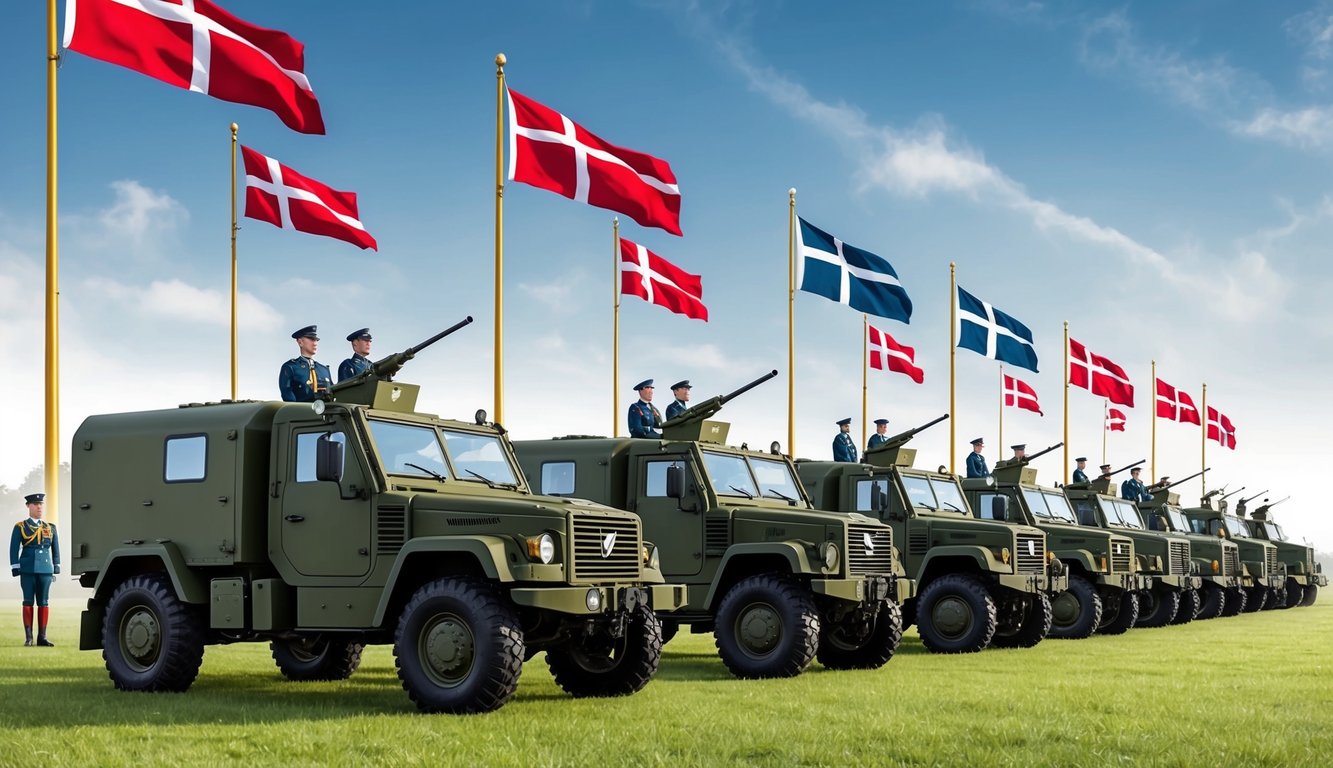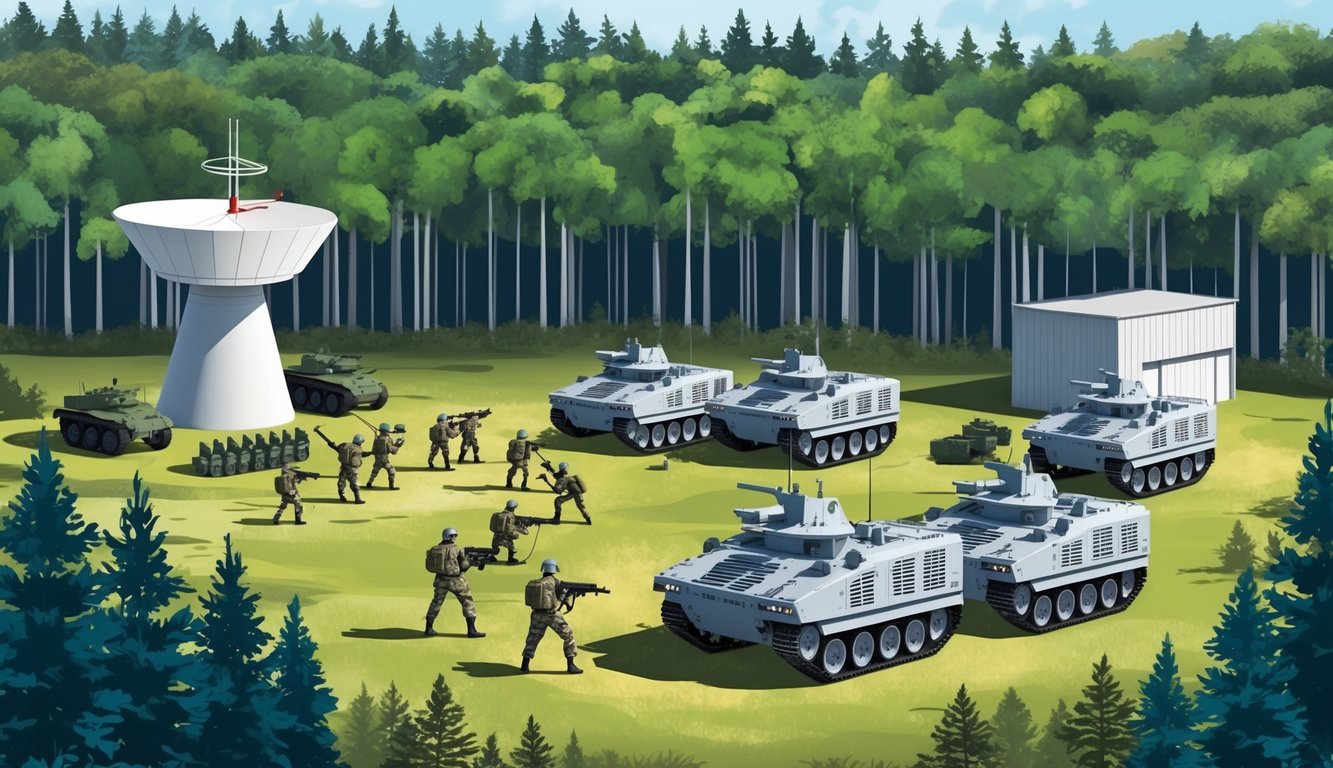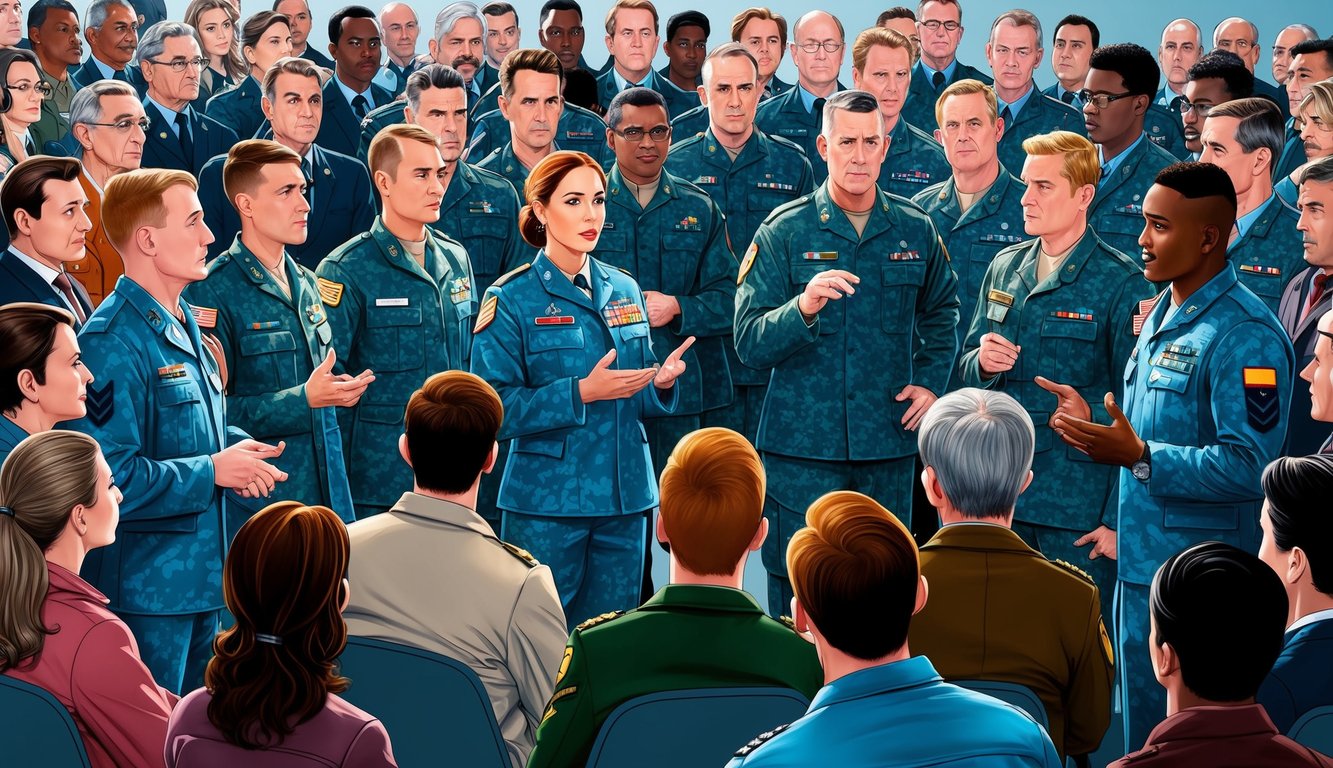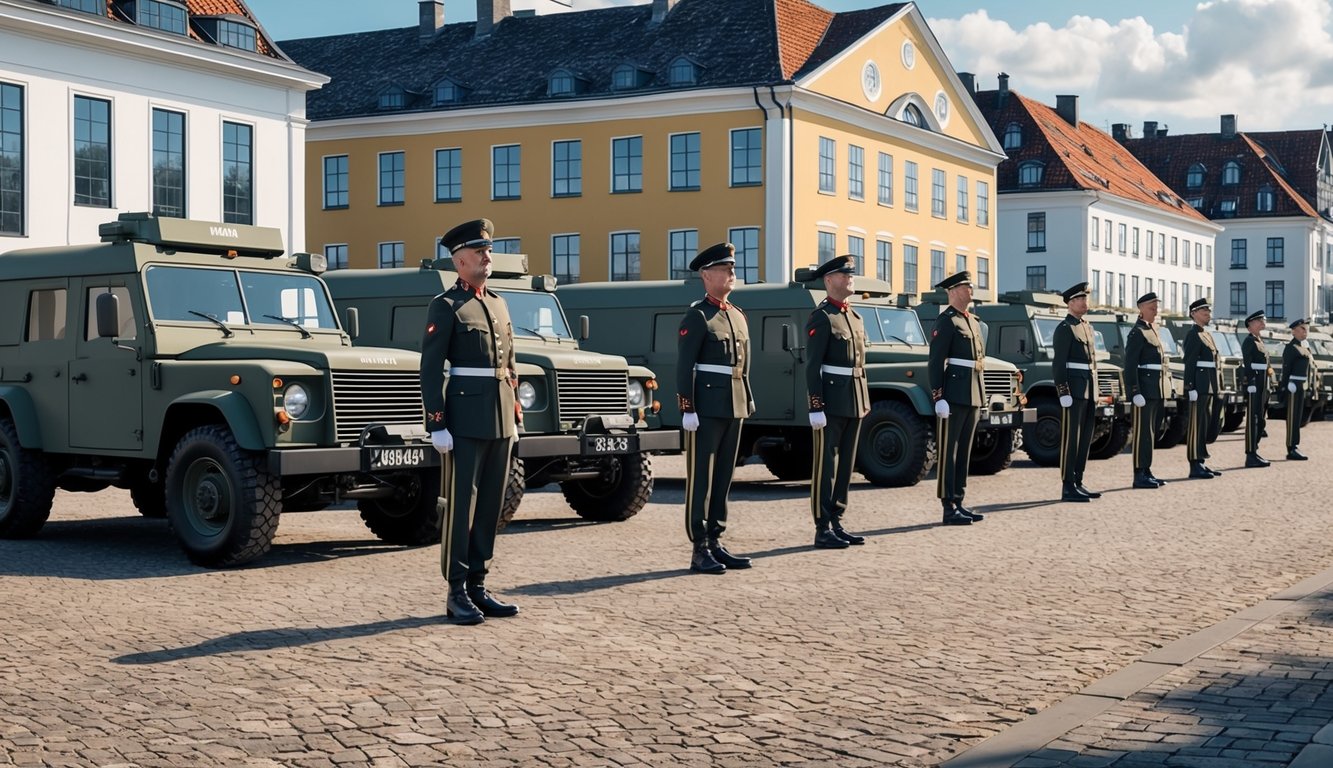The Danish military, officially referred to as the Danish Armed Forces or Forsvaret, is vital for upholding the country’s sovereignty and engaging in global peacekeeping initiatives.
Although Denmark is a relatively small nation, its military is modern and well-equipped, making significant contributions on a worldwide scale.
As a NATO member, the Danish Armed Forces are integrated into the alliance’s collective defense framework.
Danish troops have taken part in numerous international missions, ranging from Afghanistan to Mali, highlighting their dedication to global security.
Additionally, they hold particular responsibilities, such as defending Greenland and the Faroe Islands, which are part of the Kingdom of Denmark.
In recent years, Denmark has been ramping up its defense budget and modernizing its military capabilities.
Investments include acquiring new fighter jets, naval vessels, and enhancing cybersecurity.
The Danish Armed Forces are evolving to tackle emerging threats and challenges in a constantly shifting global security environment.
Key Takeaways
- Denmark’s military is a contemporary force actively engaged in international missions and NATO operations.
- The Danish Armed Forces are tasked with the defense of Denmark, Greenland, and the Faroe Islands.
- Denmark is focusing on military modernization to meet evolving security challenges.
Historical Overview
The history of Denmark’s military spans centuries, encompassing various conflicts, alliances, and strategic transformations that have shaped the nation’s defense policies and international relations.
Early Conflicts and the Thirty Years’ War
Denmark’s participation in early European conflicts laid the groundwork for its military evolution.
Notably, Danish forces were integral to the Thirty Years’ War (1618-1648), with King Christian IV leading Denmark into the fray in 1625 to establish itself as a preeminent Protestant power in Northern Europe.
Regrettably, this endeavor did not lead to the anticipated success, culminating in a significant defeat at the Battle of Lutter in 1626.
This loss compelled Denmark to exit the war in 1629, resulting in the Treaty of Lübeck.
Despite this setback, the conflict catalyzed important reforms in Denmark’s military organization and strategy.
The Napoleonic Wars and Aftermath
Fast forward to the early 19th century, and Denmark found itself embroiled in the Napoleonic Wars, which left a lasting imprint on the nation’s military and political landscape.
Initially, Denmark sought to remain neutral, but ultimately aligned itself with Napoleon, leading to a British assault on Copenhagen in 1807 that resulted in the capture of the Danish fleet.
The aftermath of the war marked several significant changes:
- Loss of Norway to Sweden in 1814
- Reorganization of the Danish army
- A shift in military strategy towards coastal defense
These developments had a profound influence on Denmark’s approach to international relations and its defense strategies for years to come.
Cold War Era Developments
During the Cold War, Denmark’s military focus shifted markedly.
As a founding NATO member in 1949, Denmark was essential to the alliance’s northern defense posture.
Important advancements from this era included:
- Modernization of military equipment and training protocols
- Increased collaboration with fellow NATO allies
- A heightened focus on territorial defense in response to potential Soviet threats
Denmark’s strategic positioning in the Baltic Sea augmented its role in NATO’s deterrence strategies, which resulted in significant investment in aerial defense systems and coastal surveillance.
This period also saw a transformation from a conscription-based military to a more professionalized armed force, geared toward addressing emerging global challenges and participating in peacekeeping missions.
Organization of The Danish Military

The Danish military comprises four principal branches, each assigned unique roles and responsibilities.
These branches operate jointly under the unified Defence Command to protect Denmark’s interests and participate in international missions.
Royal Danish Army
The Royal Danish Army serves as the land component of the Danish military.
It’s structured into two brigades: the 1st Brigade, which specializes in international missions, and the 2nd Brigade, oriented towards territorial defense.
Key units within the army include:
- Armored infantry battalions
- Artillery battalions
- Combat engineer teams
- Special forces (Jægerkorpset)
Army Command manages approximately 110 personnel responsible for operations and planning.
Training facilities throughout Denmark ensure soldiers are prepared for diverse missions.
Royal Danish Navy
The Royal Danish Navy is pivotal for Denmark’s maritime defense and operates in two squadrons:
- 1st Squadron: Consisting of larger combat vessels
- 2nd Squadron: Comprising patrol craft and mine countermeasure vessels
The navy’s fleet includes frigates, patrol vessels, and support ships, along with the elite Frømandskorpset, a specialized maritime operations unit.
Naval bases in Frederikshavn and Korsør provide strategic support for fleet activities in Danish waters and global operations.
Royal Danish Air Force
The Royal Danish Air Force is responsible for safeguarding Danish airspace and supporting land operations.
Its arsenal features:
- F-16 fighter jets (set to be replaced by F-35s)
- C-130J transport planes
- EH101 Merlin helicopters
- Challenger CL-604 maritime patrol aircraft
Air bases are located throughout Denmark, primarily in Karup, Skrydstrup, and Aalborg.
The Air Force also has search and rescue operations and supports NATO’s air policing efforts.
Danish Home Guard
The Danish Home Guard, though often overlooked, is an essential element of Denmark’s defense system.
This volunteer force consists of around 46,000 members, divided into:
- Army Home Guard
- Naval Home Guard
- Air Force Home Guard
These volunteers assist regular forces with duties such as:
- Border security
- Search and rescue operations
- Disaster relief efforts
The Home Guard provides local expertise and additional personnel during emergencies, making it a crucial part of Denmark’s comprehensive defense strategy.
Danish Defense Policy
The Danish defense policy is designed to protect national interests while fostering international peace and security.
Denmark adopts a collaborative strategy, balancing domestic demands with NATO obligations and partnerships in the region.
Defence Agreement
The Danish Parliament has recently ratified a historic defense agreement for the period from 2024 to 2033.
This long-term strategy significantly enhances military expenditure and capacity.
An allocation of 40.5 billion Danish kroner is earmarked for expedited modernization of key military assets and support for Ukraine.
Prime Minister Mette Frederiksen has stressed the importance of fortifying Denmark’s defenses in response to changing security dynamics.
Conscription and Recruitment
Denmark employs a distinctive conscription system.
Upon turning 18, individuals are required to attend “Defense Day,” although military service is predominantly voluntary.
Approximately 4,200 conscripts serve annually, primarily in the army and emergency services.
The Danish military actively seeks volunteers for specialized roles to ensure operational readiness.
There are options for both short-term and long-term service across different branches.
Nordic Defence Cooperation
Denmark plays a significant role in Nordic Defence Cooperation (NORDEFCO).
This collaborative framework with Sweden, Norway, Finland, and Iceland emphasizes joint training, capability sharing, and coordinated responses to regional security threats.
Initiatives include air policing, cyber defense, and operations in the Arctic.
Denmark’s involvement in NORDEFCO enhances its NATO engagements, presenting a multi-layered approach to national and regional security.
Military Equipment and Capabilities
Denmark’s armed forces are equipped with a diverse range of modern military assets across land, sea, and air.
They have access to advanced tanks, armored vehicles, naval ships, and aircraft that bolster the country’s defense capabilities and its international obligations.
Land Warfare Assets
The Royal Danish Army utilizes a combination of state-of-the-art armored vehicles and artillery.
You’ll see Leopard 2A7 main battle tanks in action, delivering formidable offensive and defensive capabilities.
For troop transport and reconnaissance, the army employs Piranha V armored personnel carriers, a modern upgrade from the older M113 models.
Danish infantry units are equipped with assault rifles, such as the Colt Canada C8, and light anti-tank weapons like the M72 LAW.
For artillery support, the army deploys M109A3 self-propelled howitzers, known for their long-range firing precision.
Additionally, the army operates specialized engineering vehicles and mobile air defense systems to enhance ground operations and guard against aerial threats.
Naval Vessels
Denmark’s navy maintains a fleet of advanced warships designed to protect its extensive coastline and maritime interests.
The Iver Huitfeldt-class frigates patrol the waters, equipped with sophisticated radar and missile systems for air and sea defense.
For coastal operations, Absalon-class support ships and Thetis-class ocean patrol vessels are utilized for diverse missions, including maritime security and humanitarian relief.
Smaller patrol vessels, like the Knud Rasmussen-class, carry out sovereignty patrols in Greenland, while Diana-class craft monitor Danish territorial waters.
Aircraft and Air Defense Systems
The Royal Danish Air Force operates a fleet of F-16 Fighting Falcon multirole fighters, which will soon be succeeded by F-35 Lightning II stealth jets, significantly enhancing Denmark’s combat capabilities.
For maritime patrol and anti-submarine operations, the Challenger CL-604 aircraft are deployed.
The air force also includes C-130J Super Hercules transport planes for tactical airlift tasks.
Helicopter support is provided by AW101 Merlin and MH-60R Seahawk helicopters, which are assigned to search and rescue, anti-submarine operations, and various transport duties.
Ground-based air defense is managed with upgraded I-HAWK surface-to-air missile systems, ensuring medium-range protection against aerial threats.
Current Military Engagements

Denmark’s armed forces have participated in numerous international missions in recent years, including combat and peacekeeping operations that reflect the nation’s dedication to global security.
War in Afghanistan
Denmark was notably involved in Afghanistan from 2002 to 2021, primarily operating in the volatile Helmand province.
Danish troops concentrated on combat missions and the training of Afghan security personnel.
This operation resulted in the loss of 43 Danish soldiers, marking Denmark’s longest and most expensive military commitment since World War II.
The Danish military concluded its role in Afghanistan in 2021 alongside the NATO withdrawal.
Iraq War
Denmark’s engagement in Iraq commenced in 2003, where Danish forces took on both combat and non-combat responsibilities.
Initially, Danish troops participated in direct combat alongside coalition forces, but later shifted to training Iraqi security forces.
By 2007, Denmark had withdrawn the majority of its combat troops, maintaining a smaller presence to provide training and support.
In the years since, Danish forces have also contributed to efforts against ISIS in Iraq.
Peacekeeping and International Operations
Danish troops are frequently involved in peacekeeping efforts worldwide, often participating in UN or NATO-led missions.
Denmark’s contributions include deployments in:
- Kosovo (KFOR)
- Mali (MINUSMA)
- South Sudan (UNMISS)
These missions focus on peace maintenance, civilian protection, and support for local governance.
Danish personnel often undertake specialized roles, including medical assistance or serving as military observers.
Military Support to Ukraine
Since 2022, Denmark has been actively aiding Ukraine in its defense against Russian aggression.
This support includes:
- Provision of military equipment and weaponry
- Training programs for Ukrainian soldiers
- Financial support for Ukraine’s defense initiatives
Denmark has supplied anti-tank weapons, armored vehicles, and artillery systems and is taking part in international training efforts for Ukrainian forces across multiple military disciplines.
This assistance underscores Denmark’s commitment to European security and its stance against military hostility in the region.
Denmark and International Relations
Denmark’s international military partnerships are pivotal to shaping its defense strategy and exerting global influence.
The nation strives to balance obligations to core allies with its regional security concerns and responsibilities towards its autonomous territories.
Alliances with the United States and NATO
Denmark maintains a strong commitment to its alliances with the United States and NATO.
As a founding member of NATO, Denmark has been instrumental in reinforcing the organization’s northern territory.
The nation actively engages in international peacekeeping operations and military interventions.
Recently, Denmark has deepened its relationship with the U.S. through a bilateral Defense Cooperation Agreement that facilitates a more permanent U.S. military presence at select Danish installations.
A comprehensive understanding of Denmark’s military approach includes recognition of its substantial collaboration with the U.S. on regional and global security concerns.
Security in the Baltic Sea Region
Denmark places a significant emphasis on security within the Baltic Sea region, collaborating closely with neighboring countries like Sweden, Finland, and Norway to ensure stability in this strategically pivotal area.
There is heightened focus on countering potential threats from Russia, with Denmark supporting initiatives to improve regional defense capabilities and enhance cooperation among Baltic and Nordic states.
Due to its geographic location, Denmark plays a vital role in monitoring maritime activities and ensuring the freedom of navigation within the Baltic Sea.
Greenland and Faroe Islands Defense
Denmark’s defense responsibilities extend to Greenland and the Faroe Islands, two autonomous territories vital to the nation’s strategic interests in the North Atlantic and Arctic regions.
The presence of U.S. military forces in Greenland at Thule Air Base underscores the significance of this territory in NATO’s defense strategies.
Denmark seeks to balance its own sovereignty concerns alongside alliance commitments in these territories.
Understanding Denmark’s complex defense role in these regions clarifies its broader Arctic strategy and its relationship with the U.S.
Domestic and Regional Security

The Danish military is fundamental in ensuring national security and promoting regional stability.
The armed forces work in close coordination with civilian authorities and international partners to tackle various security challenges.
Home Guard’s Role
The Danish Home Guard, or Hjemmeværnet, comprises a volunteer force supporting Denmark’s defense and emergency management activities.
These committed volunteers assist with tasks like border security, search and rescue missions, and disaster management.
The Home Guard also provides support to law enforcement during significant events and emergencies.
With approximately 15,000 active members, this force serves as a critical component of Denmark’s internal security framework.
They participate in regular training to ensure preparedness and can be rapidly deployed when necessary.
Maritime Security Operations
Given Denmark’s extensive coastline and strategic position, maritime security is of paramount importance.
The Royal Danish Navy routinely patrols Danish waters, along with the North Atlantic and Baltic Sea.
Naval vessels monitor shipping routes, combat illegal activities, and engage in search and rescue operations.
The navy also plays a significant role in safeguarding Denmark’s offshore assets, such as oil and gas installations.
Cooperation with other Nordic countries and NATO allies further bolsters these efforts to ensure maritime safety in the region.
Joint Operations and Training Exercises
To improve readiness and interoperability, Danish military units frequently engage in joint operations and training exercises.
Notable units such as the Jutland Dragoon Regiment participate in these exercises both domestically and abroad.
These training sessions often include NATO allies and Nordic partners, focusing on scenarios ranging from territorial defense to crisis response management.
By collaborating in exercises, Danish forces enhance their operational capabilities and strengthen regional cooperation on security issues.
Recent joint exercises have encompassed initiatives like Baltic Operations (BALTOPS) and Cold Response, underscoring Denmark’s commitment to collective defense and stabilization in the region.
Economics of Defense

Denmark is significantly increasing its military budget to enhance national security and adhere to NATO commitments.
Expect major funding directed towards defense capabilities and the upkeep of existing military assets in the upcoming years.
Government Defense Expenditure
Denmark’s defense budget is projected to see substantial growth, with the government pledging to meet NATO’s 2% of GDP mark for defense spending by 2030, marking a notable increase from the prior 1% allocation.
Anticipated expenditures amount to approximately 143 billion Danish kroner (over $20 billion) from 2024 to 2033, targeting essential enhancements in Denmark’s military capacities.
The annual defense expenditure is expected to reach 36.2 billion kroner in 2024, which encompasses funds earmarked for purchasing new equipment and upgrading existing systems.
Maintenance of Military Assets
Adequate maintenance of military equipment is vital for Denmark’s defense preparedness.
An increased budget will support ongoing maintenance and improvement of existing assets.
Investments will focus on modernizing naval ships, aircraft, and ground vehicles, ensuring that they remain operationally capable and technologically advanced.
Moreover, the Danish military is focusing on enhancing maintenance facilities and training programs.
These efforts aim to prolong the lifespan of equipment while reducing long-term costs.
Effective asset management enables Denmark to maximize its defense investments, which is an essential aspect of the strategy to develop a more capable and sustainable military force.
Personnel and Culture

The Danish Armed Forces champion diversity and cultivate a strong community ethos among personnel.
An array of active and reserve members serve across the Army, Navy, and Air Force, each playing a part in Denmark’s defense and international operations.
Life in the Armed Forces
Life as a member of the Danish military offers a balance of professional development and camaraderie.
Daily life typically includes physical training, skill enhancement, and team exercises.
The Danish Armed Forces emphasize a healthy work-life balance and offer flexible schedules when feasible.
Opportunities for education and advancement are available within the military framework.
Cultural sensitivity training is a priority, equipping personnel for both domestic and international missions.
The military provides language education and cultural awareness training to improve effectiveness in multilateral operations.
Active and Reserve Personnel
The Danish military consists of around 16,000 active members and 12,000 reserves.
As an active service member, you will be fully engaged with the military serving in various capacities across the Army, Navy, or Air Force.
Reserve forces play an important supportive role, balancing civilian careers with military responsibilities.
Regular training is necessary to maintain readiness, and reserves may be called upon to assist full-time forces during emergencies or significant exercises.
Both active and reserve personnel contribute to Denmark’s defense capabilities and its international commitments.
Your service, whether full-time or part-time, is crucial for preserving the nation’s military readiness and fulfilling NATO obligations.
Frequently Asked Questions

Here are answers to some common questions regarding the Danish military’s requirements, ranks, pay scales, and more.
How can someone join the Danish Army?
To enlist in the Danish Army, you must be at least 18 years old and hold Danish citizenship.
The selection process includes passing physical and psychological evaluations, followed by initial training, basic training, and specialized training for your chosen role.
What is the global ranking of Denmark’s military?
Denmark’s military is estimated to rank around 50th in the world concerning overall capability.
This ranking takes into account variables such as manpower, equipment, and budget.
Despite its relatively small size, the Danish military is highly equipped and trained.
What’s the typical salary for someone in the Danish Armed Forces?
Salaries within the Danish Armed Forces vary according to rank and experience, with privates typically earning about 20,000 Danish kroner monthly.
Officers and specialists can receive considerably higher compensation.
The military also offers benefits like housing and educational support.
What are the various branches of the military in Denmark called?
The Danish military comprises three primary branches: the Royal Danish Army, the Royal Danish Navy, and the Royal Danish Air Force.
Additionally, there is the Danish Home Guard, which operates as a volunteer reserve force.
Are citizens required to serve in the military in Denmark?
Denmark employs a selective conscription system.
All males aged 18 are obliged to participate in Defense Day, where they undergo assessment for potential military service.
However, there typically are enough volunteers to fulfill the armed forces needs.
What kind of equipment does the Danish Army use?
The Danish Army utilizes modern military equipment, including Leopard 2 tanks, CV90 infantry fighting vehicles, and various artillery systems.
Meanwhile, the Air Force operates F-16 fighter jets, with F-35s on order, and the Navy possesses frigates, patrol vessels, and submarines.

